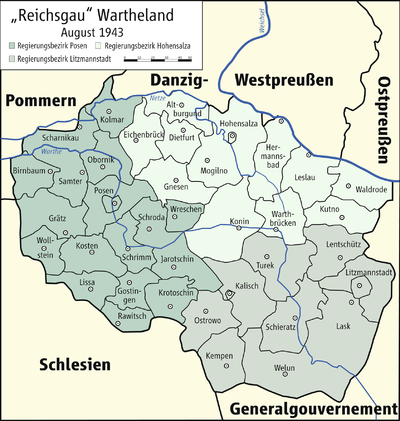Altburgund district

Altburgund district was the name of a German administrative unit in occupied Poland (1939–45) during World War II .
history
The area around the town of Szubin ( Schubin ) belonged to the Prussian province of Posen as the district of Schubin from 1815 to 1919 . After the Wielkopolska Uprising , the southern part of the district was controlled by Polish militias from January 1919. With the signing of the Versailles Treaty on June 28, 1919, the German Reich had to officially cede the entire district area to the newly founded Poland. At the beginning of the Second World War , German troops occupied the western Polish Powiat Szubin , the district town of Szubin was taken on September 6, 1939. On October 26, 1939, the district was annexed to the German Reich in violation of international law under the name of Landkreis Altburgund .
The new name "Altburgund" was intended to refer to the East Germanic prehistory of the region as the presumed home of the Burgundians . This artificial name was not only unpopular with the Polish majority, but also with the German-speaking minority. The name of the district was therefore changed several times, first on May 21, 1941 in the district of Schubin, then on July 24, 1942 in the district of Altburgund (Schubin) and finally on October 7, 1942 again in the district of Altburgund. The district was part of the administrative district Hohensalza in the Reichsgau Wartheland .
The seat of the German district office was the district town of Schubin , whose name also changed several times.
After the invasion of the Red Army at the end of January 1945, all German regulations were repealed and the area became part of Poland again. The district area today largely belongs to the Polish powiat Nakielski .
politics
Land Commissioner
- 1939 :?
District administrators
- 1939–1940:?
- 1940– : Zülch
Size & structure
The district of Altburgund had an area of 917 km².
The 97 localities in the district were initially grouped into 8 administrative districts . On January 1, 1942, the district of Schubin was named a city according to the German municipal code of 1935. The number of administrative districts was reduced to four on July 1, 1942: Schubin, Bartschin , Exin and Labischin .
population
The district of Altburgund had in 1941: 45,752 mostly Polish inhabitants. The composition of the population changed greatly between 1918 and 1945, as both the German and Polish authorities tried to change the situation in their own favor through repression and resettlement. The proportion of the German-speaking population fell from approx. 44% in 1890 to approx. 20% in 1931. Between December 1, 1939 and December 31, 1943, the German authorities expelled over 2,600 Poles from the area Settlement organized by Germans. All German-speaking residents had to leave the area in 1945.
The Jewish population was deported to the General Government after 1939 and later mostly murdered there.
Place names
The local authorities immediately gave all localities in the district with German names, although officially according to the unpublished decree of the Interior Minister of December 29, 1939, the German names valid from 1918 should initially continue to apply. On May 18, 1943, German names were set for all places with a post or train station in Wartheland , although there were again deviations.
List of cities and administrative districts in the "Landkreis Altburgund":
| Polish name | German name (1918) | German name (1939-1945) |
|---|---|---|
| Barcin | Bartschin |
1939–1943 Bartelstein an der Netze 1943–1945 Bartelstädt |
| Kcynia | Exin |
1939–1940 Prien am Berge 1940–1945 Exin |
| Łabiszyn | Labishin | Luderitz |
| Szubin | Schubin |
1939–1941 Altburgund 1941–1942 Schubin 1942–1945 Altburgund |
literature
- The Schubin district. History, memories, sketches. Published by Heimatkreis Schubin-Altburgund eV Bergen in 1990.
Web links
- Altburgund district administrative history and the district administrators on the website territorial.de (Rolf Jehke), as of August 17, 2013.